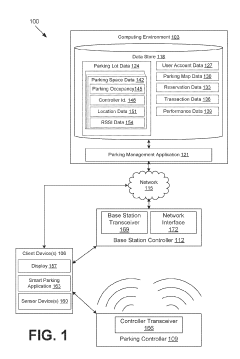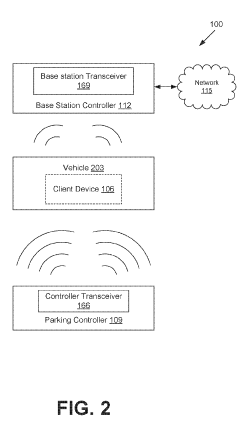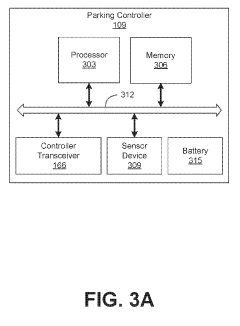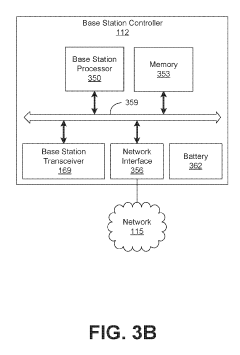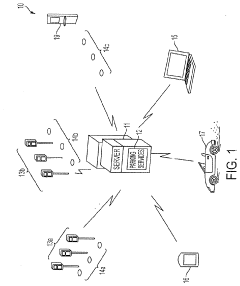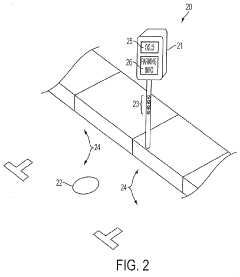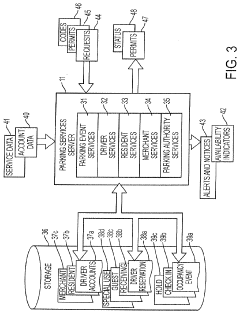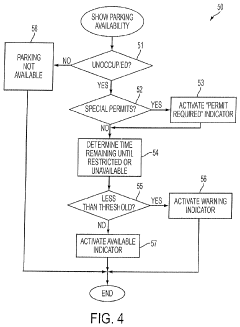How 5G UC Drives Innovation in Smart Parking Solutions
JUL 18, 20259 MIN READ
Generate Your Research Report Instantly with AI Agent
Patsnap Eureka helps you evaluate technical feasibility & market potential.
5G UC and Smart Parking: Background and Objectives
The convergence of 5G Ultra-Capacity (UC) technology and smart parking solutions represents a significant leap forward in urban infrastructure management. This technological synergy aims to address the growing challenges of parking in densely populated urban areas, where inefficient parking systems lead to traffic congestion, increased emissions, and driver frustration.
5G UC, the latest iteration of fifth-generation cellular network technology, offers unprecedented data transmission speeds, ultra-low latency, and massive device connectivity. These capabilities provide the foundation for transforming traditional parking systems into intelligent, responsive, and highly efficient solutions. The primary objective of integrating 5G UC with smart parking is to create a seamless, real-time parking management ecosystem that benefits both drivers and city planners.
The evolution of parking technology has progressed from simple mechanical meters to digital systems, and now to connected, sensor-based solutions. However, the limitations of previous communication technologies have hindered the full realization of smart parking potential. 5G UC addresses these limitations, enabling the deployment of a vast network of sensors, cameras, and IoT devices that can communicate instantaneously and process large volumes of data in real-time.
Smart parking solutions powered by 5G UC aim to optimize parking space utilization, reduce search times for available spots, and enhance the overall parking experience. These systems can provide drivers with accurate, up-to-the-minute information on parking availability, pricing, and navigation to the nearest open space. For city administrators, the technology offers valuable insights into parking patterns, enabling data-driven decision-making for urban planning and resource allocation.
The integration of 5G UC in smart parking aligns with broader smart city initiatives, contributing to reduced traffic congestion, lower carbon emissions, and improved quality of life for urban residents. It also opens up new possibilities for innovative services, such as predictive parking availability, automated parking enforcement, and integration with electric vehicle charging infrastructure.
As cities worldwide grapple with increasing urbanization and the need for sustainable transportation solutions, the combination of 5G UC and smart parking technologies presents a promising avenue for addressing these challenges. The goal is to create more livable, efficient, and environmentally friendly urban spaces through the intelligent management of parking resources.
5G UC, the latest iteration of fifth-generation cellular network technology, offers unprecedented data transmission speeds, ultra-low latency, and massive device connectivity. These capabilities provide the foundation for transforming traditional parking systems into intelligent, responsive, and highly efficient solutions. The primary objective of integrating 5G UC with smart parking is to create a seamless, real-time parking management ecosystem that benefits both drivers and city planners.
The evolution of parking technology has progressed from simple mechanical meters to digital systems, and now to connected, sensor-based solutions. However, the limitations of previous communication technologies have hindered the full realization of smart parking potential. 5G UC addresses these limitations, enabling the deployment of a vast network of sensors, cameras, and IoT devices that can communicate instantaneously and process large volumes of data in real-time.
Smart parking solutions powered by 5G UC aim to optimize parking space utilization, reduce search times for available spots, and enhance the overall parking experience. These systems can provide drivers with accurate, up-to-the-minute information on parking availability, pricing, and navigation to the nearest open space. For city administrators, the technology offers valuable insights into parking patterns, enabling data-driven decision-making for urban planning and resource allocation.
The integration of 5G UC in smart parking aligns with broader smart city initiatives, contributing to reduced traffic congestion, lower carbon emissions, and improved quality of life for urban residents. It also opens up new possibilities for innovative services, such as predictive parking availability, automated parking enforcement, and integration with electric vehicle charging infrastructure.
As cities worldwide grapple with increasing urbanization and the need for sustainable transportation solutions, the combination of 5G UC and smart parking technologies presents a promising avenue for addressing these challenges. The goal is to create more livable, efficient, and environmentally friendly urban spaces through the intelligent management of parking resources.
Market Analysis for 5G-Enabled Smart Parking
The smart parking market is experiencing significant growth, driven by the increasing adoption of 5G technology and the rising demand for efficient urban mobility solutions. As cities worldwide grapple with traffic congestion and parking challenges, 5G-enabled smart parking systems offer a promising solution to optimize parking management and enhance the overall urban experience.
The global smart parking market is projected to expand rapidly in the coming years, with estimates suggesting a compound annual growth rate (CAGR) of over 20% from 2021 to 2026. This growth is primarily attributed to the integration of advanced technologies such as 5G, IoT, and AI in parking management systems. The market size is expected to reach several billion dollars by 2026, reflecting the increasing investments in smart city initiatives and the growing awareness of the benefits of intelligent parking solutions.
Key factors driving the market demand for 5G-enabled smart parking include the need for reduced traffic congestion, improved parking efficiency, and enhanced user experience. Urban areas, particularly in developed countries, are witnessing a surge in vehicle ownership, leading to severe parking shortages and traffic management issues. Smart parking solutions powered by 5G technology address these challenges by providing real-time parking availability information, automated payment systems, and predictive analytics for better resource allocation.
The market for 5G-enabled smart parking solutions is segmented based on various factors, including deployment type (on-street and off-street parking), end-user (commercial and residential), and geography. On-street parking solutions are expected to witness higher growth due to the increasing focus on reducing traffic congestion in city centers. Commercial applications, particularly in shopping malls, airports, and corporate offices, are likely to dominate the market share owing to the high volume of vehicles and the need for efficient parking management.
Geographically, North America and Europe are currently leading the smart parking market, with Asia-Pacific expected to exhibit the highest growth rate in the coming years. This regional disparity is attributed to differences in infrastructure development, technological adoption rates, and government initiatives promoting smart city projects.
The COVID-19 pandemic has had a mixed impact on the smart parking market. While the initial lockdowns and reduced mobility temporarily slowed market growth, the pandemic has also accelerated the adoption of contactless and automated parking solutions, aligning well with the capabilities of 5G-enabled smart parking systems.
Looking ahead, the market for 5G-enabled smart parking is poised for substantial growth, driven by ongoing urbanization, increasing vehicle ownership, and the push for smarter, more sustainable cities. As 5G networks continue to expand and mature, the potential for innovative parking solutions that leverage high-speed, low-latency connectivity will only increase, opening up new opportunities for market players and urban planners alike.
The global smart parking market is projected to expand rapidly in the coming years, with estimates suggesting a compound annual growth rate (CAGR) of over 20% from 2021 to 2026. This growth is primarily attributed to the integration of advanced technologies such as 5G, IoT, and AI in parking management systems. The market size is expected to reach several billion dollars by 2026, reflecting the increasing investments in smart city initiatives and the growing awareness of the benefits of intelligent parking solutions.
Key factors driving the market demand for 5G-enabled smart parking include the need for reduced traffic congestion, improved parking efficiency, and enhanced user experience. Urban areas, particularly in developed countries, are witnessing a surge in vehicle ownership, leading to severe parking shortages and traffic management issues. Smart parking solutions powered by 5G technology address these challenges by providing real-time parking availability information, automated payment systems, and predictive analytics for better resource allocation.
The market for 5G-enabled smart parking solutions is segmented based on various factors, including deployment type (on-street and off-street parking), end-user (commercial and residential), and geography. On-street parking solutions are expected to witness higher growth due to the increasing focus on reducing traffic congestion in city centers. Commercial applications, particularly in shopping malls, airports, and corporate offices, are likely to dominate the market share owing to the high volume of vehicles and the need for efficient parking management.
Geographically, North America and Europe are currently leading the smart parking market, with Asia-Pacific expected to exhibit the highest growth rate in the coming years. This regional disparity is attributed to differences in infrastructure development, technological adoption rates, and government initiatives promoting smart city projects.
The COVID-19 pandemic has had a mixed impact on the smart parking market. While the initial lockdowns and reduced mobility temporarily slowed market growth, the pandemic has also accelerated the adoption of contactless and automated parking solutions, aligning well with the capabilities of 5G-enabled smart parking systems.
Looking ahead, the market for 5G-enabled smart parking is poised for substantial growth, driven by ongoing urbanization, increasing vehicle ownership, and the push for smarter, more sustainable cities. As 5G networks continue to expand and mature, the potential for innovative parking solutions that leverage high-speed, low-latency connectivity will only increase, opening up new opportunities for market players and urban planners alike.
Current 5G UC Technology in Smart Parking
The current 5G UC (Ultra-Capacity) technology in smart parking solutions represents a significant leap forward in connectivity and data processing capabilities. This advanced network infrastructure enables real-time communication between various components of smart parking systems, facilitating seamless integration and enhanced functionality.
One of the key features of 5G UC in smart parking is its ultra-low latency, which allows for near-instantaneous data transmission. This is crucial for applications such as real-time parking space availability updates, automated parking guidance systems, and vehicle-to-infrastructure (V2I) communication. The reduced latency ensures that drivers receive up-to-date information about parking spaces, reducing traffic congestion and improving overall parking efficiency.
The high bandwidth capacity of 5G UC networks supports the transmission of high-definition video streams from parking lot cameras. This enables advanced video analytics for parking space monitoring, security surveillance, and license plate recognition. The improved video quality and processing capabilities enhance the accuracy of parking space detection and vehicle identification systems.
5G UC technology also facilitates the deployment of a dense network of IoT sensors throughout parking facilities. These sensors can monitor various parameters such as occupancy status, environmental conditions, and vehicle movements. The massive machine-type communications (mMTC) feature of 5G allows for the simultaneous connection of a large number of these sensors, providing comprehensive data collection for smart parking management systems.
The edge computing capabilities enabled by 5G UC networks bring data processing closer to the source, reducing the need for centralized data centers. This distributed computing approach allows for faster decision-making and more efficient resource allocation in smart parking systems. For example, edge computing can be used for local processing of video feeds, reducing the bandwidth requirements for data transmission to central servers.
Another significant application of 5G UC in smart parking is the support for autonomous valet parking systems. The high-speed, low-latency network enables precise coordination between vehicles and parking infrastructure, allowing for safe and efficient autonomous parking operations. This technology has the potential to revolutionize parking in urban areas by maximizing space utilization and improving the overall parking experience.
The integration of 5G UC with blockchain technology is also being explored in smart parking solutions. This combination can enhance the security and transparency of parking transactions, enabling features such as decentralized payment systems and tamper-proof parking records. The high-speed network ensures that blockchain transactions can be processed quickly, maintaining the real-time nature of parking operations.
In conclusion, the current 5G UC technology in smart parking solutions offers a robust foundation for innovative and efficient parking management systems. Its high-speed, low-latency, and high-capacity characteristics enable a wide range of advanced features that significantly improve the parking experience for both drivers and parking facility operators.
One of the key features of 5G UC in smart parking is its ultra-low latency, which allows for near-instantaneous data transmission. This is crucial for applications such as real-time parking space availability updates, automated parking guidance systems, and vehicle-to-infrastructure (V2I) communication. The reduced latency ensures that drivers receive up-to-date information about parking spaces, reducing traffic congestion and improving overall parking efficiency.
The high bandwidth capacity of 5G UC networks supports the transmission of high-definition video streams from parking lot cameras. This enables advanced video analytics for parking space monitoring, security surveillance, and license plate recognition. The improved video quality and processing capabilities enhance the accuracy of parking space detection and vehicle identification systems.
5G UC technology also facilitates the deployment of a dense network of IoT sensors throughout parking facilities. These sensors can monitor various parameters such as occupancy status, environmental conditions, and vehicle movements. The massive machine-type communications (mMTC) feature of 5G allows for the simultaneous connection of a large number of these sensors, providing comprehensive data collection for smart parking management systems.
The edge computing capabilities enabled by 5G UC networks bring data processing closer to the source, reducing the need for centralized data centers. This distributed computing approach allows for faster decision-making and more efficient resource allocation in smart parking systems. For example, edge computing can be used for local processing of video feeds, reducing the bandwidth requirements for data transmission to central servers.
Another significant application of 5G UC in smart parking is the support for autonomous valet parking systems. The high-speed, low-latency network enables precise coordination between vehicles and parking infrastructure, allowing for safe and efficient autonomous parking operations. This technology has the potential to revolutionize parking in urban areas by maximizing space utilization and improving the overall parking experience.
The integration of 5G UC with blockchain technology is also being explored in smart parking solutions. This combination can enhance the security and transparency of parking transactions, enabling features such as decentralized payment systems and tamper-proof parking records. The high-speed network ensures that blockchain transactions can be processed quickly, maintaining the real-time nature of parking operations.
In conclusion, the current 5G UC technology in smart parking solutions offers a robust foundation for innovative and efficient parking management systems. Its high-speed, low-latency, and high-capacity characteristics enable a wide range of advanced features that significantly improve the parking experience for both drivers and parking facility operators.
Existing 5G UC Smart Parking Solutions
01 5G Ultra-Capacity Network Architecture
5G UC refers to an advanced network architecture that provides enhanced capacity and performance in 5G networks. It utilizes a combination of mid-band and high-band spectrum to deliver faster speeds, lower latency, and increased network capacity compared to standard 5G implementations.- 5G Ultra-Capacity network architecture: 5G UC refers to an advanced network architecture that provides enhanced capacity and performance in 5G networks. It utilizes a combination of mid-band and high-band spectrum to deliver faster speeds, lower latency, and increased network capacity compared to standard 5G deployments.
- Spectrum allocation and management for 5G UC: Efficient spectrum allocation and management techniques are crucial for 5G UC networks. This involves dynamic spectrum sharing, carrier aggregation, and advanced frequency planning to optimize the use of available spectrum resources and maximize network capacity.
- Beamforming and MIMO technologies in 5G UC: 5G UC networks leverage advanced beamforming and massive MIMO (Multiple-Input Multiple-Output) technologies to improve signal quality, increase coverage, and enhance network capacity. These techniques enable more efficient use of spectrum and support higher data rates for multiple users simultaneously.
- Network slicing and virtualization for 5G UC: Network slicing and virtualization technologies are employed in 5G UC networks to create multiple logical networks on a single physical infrastructure. This allows for the customization of network resources and services to meet diverse application requirements and optimize network performance.
- Edge computing integration with 5G UC: 5G UC networks integrate edge computing capabilities to bring processing power closer to end-users and devices. This reduces latency, improves network efficiency, and enables new applications that require real-time processing and low-latency communication.
02 Spectrum Utilization in 5G UC
5G UC leverages a wide range of spectrum bands, including mid-band (typically 2.5 GHz to 6 GHz) and millimeter-wave frequencies (above 24 GHz). This multi-band approach allows for improved coverage, capacity, and data speeds in urban and high-density areas.Expand Specific Solutions03 Advanced Antenna Technologies for 5G UC
5G UC implementations often incorporate advanced antenna technologies such as Massive MIMO (Multiple-Input Multiple-Output) and beamforming. These technologies enable more efficient use of spectrum, improved signal quality, and increased network capacity.Expand Specific Solutions04 Network Slicing and Virtualization in 5G UC
5G UC networks utilize network slicing and virtualization techniques to create multiple virtual networks tailored for specific use cases or applications. This allows for optimized resource allocation and improved quality of service for different types of traffic.Expand Specific Solutions05 Edge Computing Integration with 5G UC
5G UC networks often integrate edge computing capabilities to reduce latency and improve overall network performance. By bringing computing resources closer to the end-users, 5G UC can support emerging applications such as augmented reality, autonomous vehicles, and industrial IoT.Expand Specific Solutions
Key Players in 5G UC Smart Parking
The 5G UC (Ultra Capacity) smart parking solutions market is in a growth phase, with increasing adoption driven by urbanization and the need for efficient parking management. The market size is expanding rapidly, expected to reach several billion dollars globally by 2025. Technologically, 5G UC enables real-time data transmission and low-latency communication, crucial for smart parking applications. Key players like China United Network Communications Group and ZTE Corp. are leading in 5G infrastructure development, while automotive companies such as BMW and GAC Group are integrating smart parking technologies. Universities like Xi'an Jiaotong University and Harbin Engineering University are contributing to research and innovation in this field, indicating a maturing ecosystem with diverse stakeholders.
China United Network Communications Group Co., Ltd.
Technical Solution: China Unicom has developed a comprehensive 5G-based smart parking solution that integrates IoT sensors, edge computing, and cloud platforms. Their system utilizes 5G's high bandwidth and low latency to enable real-time parking space detection and guidance. The solution incorporates AI-powered video analytics for license plate recognition and vehicle type identification, allowing for automated parking management and dynamic pricing[1]. China Unicom has also implemented a blockchain-based payment system for secure and transparent transactions in smart parking facilities[2]. The company has deployed this solution in several major cities, demonstrating significant improvements in parking efficiency and user experience[3].
Strengths: Extensive 5G network infrastructure, strong integration capabilities, and proven large-scale deployments. Weaknesses: Potential challenges in global market expansion due to geopolitical factors.
ZTE Corp.
Technical Solution: ZTE has developed a 5G-enabled smart parking platform that leverages advanced IoT sensors and edge computing technologies. Their solution uses 5G's ultra-reliable low-latency communication (URLLC) to provide real-time parking space availability and guidance to drivers[4]. ZTE's system incorporates AI-driven predictive analytics to optimize parking space utilization and reduce traffic congestion. The company has also implemented a 5G V2X (Vehicle-to-Everything) communication system to enable seamless interaction between vehicles and parking infrastructure[5]. ZTE's smart parking solution includes features such as automated license plate recognition, contactless payment systems, and integration with smart city platforms for comprehensive urban mobility management[6].
Strengths: Strong 5G technology expertise, comprehensive end-to-end solutions, and global market presence. Weaknesses: Potential security concerns and regulatory challenges in some international markets.
Core 5G UC Innovations for Smart Parking
Smart parking management and navigation system
PatentInactiveUS20190122554A1
Innovation
- A smart parking management system utilizing a base station controller and parking controllers that communicate via wireless signals, using RSSI measurements to determine vehicle presence and occupancy, allowing for real-time data transmission to a computing server and mobile devices for navigation and reservation purposes.
System and method for providing distributed on-street valet parking with the aid of a digital computer
PatentActiveUS20200013288A1
Innovation
- A distributed on-street valet parking system utilizing a centrally-located server interfaced over a computer network, with smart parking devices and vehicle occupancy sensors, that manages multiple parking spaces, provides real-time availability indicators, and allows for reservation and management of parking spaces for valet services, ensuring compliance with regulations and optimizing parking allocation.
Urban Planning and 5G UC Smart Parking
The integration of 5G UC (Ultra-Capacity) technology with smart parking solutions is revolutionizing urban planning and transportation management. This synergy addresses the growing challenges of congestion and inefficient parking systems in densely populated urban areas. By leveraging the high-speed, low-latency capabilities of 5G UC networks, smart parking solutions can provide real-time data collection, analysis, and distribution, enabling more effective urban space utilization.
5G UC's enhanced connectivity allows for the deployment of a vast network of sensors and cameras throughout parking facilities and street-side spaces. These devices can accurately detect parking space availability and transmit this information instantaneously to centralized management systems. The increased bandwidth of 5G UC supports high-definition video streaming from surveillance cameras, enabling advanced vehicle recognition and automated parking enforcement.
The implementation of 5G UC in smart parking systems facilitates dynamic pricing models based on real-time demand. This approach optimizes parking space utilization and can help reduce traffic congestion by guiding drivers to available spots more efficiently. The low latency of 5G UC networks also enables the development of autonomous valet parking services, where vehicles can be remotely guided to parking spaces without human intervention.
Urban planners can leverage the data collected through 5G UC-enabled smart parking systems to make informed decisions about infrastructure development and traffic management. The comprehensive, real-time insights into parking patterns and vehicle flow allow for more accurate predictions of future parking needs and enable adaptive urban planning strategies.
The integration of 5G UC with smart parking solutions also supports the development of intermodal transportation hubs. These hubs can seamlessly connect various modes of transportation, including personal vehicles, public transit, and shared mobility services. By providing real-time information on parking availability and transit options, these systems encourage the use of public transportation and reduce overall traffic congestion.
Furthermore, 5G UC technology enables the implementation of advanced payment systems for smart parking. Mobile applications can leverage the high-speed connectivity to process transactions quickly and securely, eliminating the need for physical payment infrastructure and reducing operational costs for parking management entities.
As cities continue to grow and evolve, the combination of 5G UC and smart parking solutions will play a crucial role in creating more efficient, sustainable, and livable urban environments. This technological integration not only addresses immediate parking challenges but also lays the foundation for future smart city initiatives and autonomous vehicle integration.
5G UC's enhanced connectivity allows for the deployment of a vast network of sensors and cameras throughout parking facilities and street-side spaces. These devices can accurately detect parking space availability and transmit this information instantaneously to centralized management systems. The increased bandwidth of 5G UC supports high-definition video streaming from surveillance cameras, enabling advanced vehicle recognition and automated parking enforcement.
The implementation of 5G UC in smart parking systems facilitates dynamic pricing models based on real-time demand. This approach optimizes parking space utilization and can help reduce traffic congestion by guiding drivers to available spots more efficiently. The low latency of 5G UC networks also enables the development of autonomous valet parking services, where vehicles can be remotely guided to parking spaces without human intervention.
Urban planners can leverage the data collected through 5G UC-enabled smart parking systems to make informed decisions about infrastructure development and traffic management. The comprehensive, real-time insights into parking patterns and vehicle flow allow for more accurate predictions of future parking needs and enable adaptive urban planning strategies.
The integration of 5G UC with smart parking solutions also supports the development of intermodal transportation hubs. These hubs can seamlessly connect various modes of transportation, including personal vehicles, public transit, and shared mobility services. By providing real-time information on parking availability and transit options, these systems encourage the use of public transportation and reduce overall traffic congestion.
Furthermore, 5G UC technology enables the implementation of advanced payment systems for smart parking. Mobile applications can leverage the high-speed connectivity to process transactions quickly and securely, eliminating the need for physical payment infrastructure and reducing operational costs for parking management entities.
As cities continue to grow and evolve, the combination of 5G UC and smart parking solutions will play a crucial role in creating more efficient, sustainable, and livable urban environments. This technological integration not only addresses immediate parking challenges but also lays the foundation for future smart city initiatives and autonomous vehicle integration.
Data Security in 5G UC Smart Parking
Data security is a critical concern in the implementation of 5G UC-enabled smart parking solutions. As these systems collect and process vast amounts of sensitive information, including vehicle locations, user identities, and payment details, robust security measures are essential to protect against potential breaches and unauthorized access.
One of the primary security challenges in 5G UC smart parking is the protection of data in transit. The high-speed, low-latency nature of 5G networks allows for real-time communication between parking sensors, vehicles, and central management systems. To safeguard this data exchange, end-to-end encryption protocols such as Transport Layer Security (TLS) and Datagram Transport Layer Security (DTLS) are employed. These protocols ensure that data remains confidential and tamper-proof as it travels across the network.
Authentication and access control mechanisms play a crucial role in maintaining the integrity of smart parking systems. Multi-factor authentication (MFA) is increasingly being adopted to verify the identity of users and devices accessing the system. This may include a combination of passwords, biometric data, and digital certificates. Additionally, role-based access control (RBAC) systems are implemented to ensure that users and devices have appropriate permissions based on their roles and responsibilities.
Data storage and retention policies are another key aspect of security in 5G UC smart parking solutions. Sensitive information must be stored securely, with encryption at rest to protect against unauthorized access in case of physical breaches. Many organizations are adopting a data minimization approach, retaining only essential information for the shortest necessary period to reduce the potential impact of data breaches.
The distributed nature of smart parking systems, with numerous IoT devices and sensors, presents unique security challenges. To address this, secure device provisioning and management protocols are essential. These include secure boot processes, regular firmware updates, and remote device monitoring to detect and respond to potential security threats.
Privacy considerations are also paramount in the design and implementation of 5G UC smart parking solutions. Anonymization and pseudonymization techniques are employed to protect user identities while still allowing for necessary data analysis and system functionality. Additionally, compliance with data protection regulations such as GDPR and CCPA is crucial, requiring transparent data handling practices and user consent mechanisms.
As 5G UC technology continues to evolve, so too must the security measures protecting smart parking systems. Emerging technologies such as blockchain are being explored for their potential to enhance data integrity and traceability in parking transactions. Furthermore, the integration of artificial intelligence and machine learning algorithms is enabling more sophisticated threat detection and response capabilities, helping to identify and mitigate potential security risks in real-time.
One of the primary security challenges in 5G UC smart parking is the protection of data in transit. The high-speed, low-latency nature of 5G networks allows for real-time communication between parking sensors, vehicles, and central management systems. To safeguard this data exchange, end-to-end encryption protocols such as Transport Layer Security (TLS) and Datagram Transport Layer Security (DTLS) are employed. These protocols ensure that data remains confidential and tamper-proof as it travels across the network.
Authentication and access control mechanisms play a crucial role in maintaining the integrity of smart parking systems. Multi-factor authentication (MFA) is increasingly being adopted to verify the identity of users and devices accessing the system. This may include a combination of passwords, biometric data, and digital certificates. Additionally, role-based access control (RBAC) systems are implemented to ensure that users and devices have appropriate permissions based on their roles and responsibilities.
Data storage and retention policies are another key aspect of security in 5G UC smart parking solutions. Sensitive information must be stored securely, with encryption at rest to protect against unauthorized access in case of physical breaches. Many organizations are adopting a data minimization approach, retaining only essential information for the shortest necessary period to reduce the potential impact of data breaches.
The distributed nature of smart parking systems, with numerous IoT devices and sensors, presents unique security challenges. To address this, secure device provisioning and management protocols are essential. These include secure boot processes, regular firmware updates, and remote device monitoring to detect and respond to potential security threats.
Privacy considerations are also paramount in the design and implementation of 5G UC smart parking solutions. Anonymization and pseudonymization techniques are employed to protect user identities while still allowing for necessary data analysis and system functionality. Additionally, compliance with data protection regulations such as GDPR and CCPA is crucial, requiring transparent data handling practices and user consent mechanisms.
As 5G UC technology continues to evolve, so too must the security measures protecting smart parking systems. Emerging technologies such as blockchain are being explored for their potential to enhance data integrity and traceability in parking transactions. Furthermore, the integration of artificial intelligence and machine learning algorithms is enabling more sophisticated threat detection and response capabilities, helping to identify and mitigate potential security risks in real-time.
Unlock deeper insights with Patsnap Eureka Quick Research — get a full tech report to explore trends and direct your research. Try now!
Generate Your Research Report Instantly with AI Agent
Supercharge your innovation with Patsnap Eureka AI Agent Platform!
